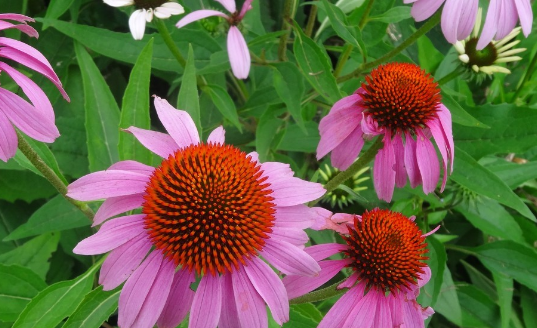How does broccoli (also known as broccoli) control diseases and insect pests? What are the characteristics? What can't you eat with?
In order to ensure the production of high quality broccoli, the prediction of diseases and insect pests should be strengthened. Based on prevention, do you know how to control diseases and insect pests in the process of planting Chinese and Western orchids? What are the characteristics? What can't you eat with?

1. How to control diseases and insect pests of broccoli
1. Downy mildew
① symptoms. It is a fungal disease, which is obvious in the process of flower head development. the old leaves first fall ill, and then spread to the young leaves. At the initial stage of the disease, there is a lack of green and the leaves turn yellow. When the leaf is dry, the mildew layer appears on the back of the leaf when it is wet.
Prevention and treatment of ②. Select varieties with strong disease resistance. To avoid continuous cropping, the soil should be deeply whitened and improved with appropriate amount of lime. In the early stage of the disease, spray with 70% mancozeb wettable powder 600-800 times, or metalaxyl 400-600 times. Stop using pesticides 10-15 days before harvest.
2. Soft rot
① symptoms. It is a bacterial disease, which is easy to occur when there are more Rain Water in the later growth stage of broccoli. The disease spot is in the shape of water stains, gradually softening and decay, resulting in a bad smell; germs invade from the wounds of roots, stems and leaves.
Prevention and treatment of ②. Avoid continuous cropping with cruciferous vegetables, especially cabbage and cabbage. Strengthen field management and cultivate strong seedlings. Avoid injury and pay attention to drainage after rain. Timely spraying streptomycin sulfate, or 72% of agricultural streptomycin wettable powder 3000-4000 times, or neophytomycin 4000 times.
3. Plutella xylostella
① symptoms. The first instar larvae could only feed on the mesophyll, leaving a transparent epidermis. The 3rd and 4th instar larvae could feed on the vegetable leaves into holes, and in severe cases, the whole leaves were eaten into a network.
Prevention and treatment of ②. At the initial stage of the disease, the adults were trapped and killed by black light. It can also be sprayed with 500-1000 times of Bacillus thuringiensis preparation, or with 50% phoxim EC 1000-2000 times. Stop using pesticides 10 days before harvest.
4. Cabbage worm
① symptoms. The larvae gnaw on the mesophyll, leaving only a layer of transparent epidermis and only veins, which is prone to soft rot when endangering the flower bulb. Insect dung will also pollute the flower ball and reduce the commodity value.
Prevention and treatment of ②. In the early stage of the disease, Bt emulsion, or cyanobacteria No. 6 liquid 500 times 800 times, or 50% phoxim EC 1000 times, or 20% fenvalerate EC 3000 times 4000 times, were sprayed. If you encounter rain after spraying, you should make up for spraying. Stop using pesticides 10 days before harvest.
5. Vegetable aphid
① symptoms. The injured plants lost water seriously, curled, yellowed, twisted and deformed. Vegetable aphids could also cause soot disease and spread virus diseases.
Prevention and treatment of ②. Set up yellow board to trap aphids in the field of broccoli, 8 pieces per mu. Hang silver gray film strip to avoid aphids, the membrane is 12cm wide and less than 1 meter high. In the early stage of the disease, spray 1000 times of dimethoate or 1000-2000 times of dichlorvos EC. Stop using pesticides 15 days before harvest.
What are the characteristics of broccoli
1. Clearing blood vessels
Eat broccoli can clear blood vessels, because broccoli is rich in flavonoids, this substance is a good vascular cleaning agent, I hope you can understand.
2. Detoxify the liver
Broccoli also has the role of detoxification, will strengthen the blood vessel wall, rich in vitamin C ingredients, can improve the body's immune capacity, is very good.
3. Anti-cancer and anti-cancer
Cauliflower contains antioxidant and anti-cancer trace elements, long-term consumption can reduce the incidence of breast, rectal and gastric cancer and other cancers. According to the American Cancer Society, cauliflower and Chinese cabbage have the best anti-cancer effect among many fruits and vegetables. Research on the effectiveness of broccoli in preventing prostate cancer is also published in the American Journal of Nutrition.
4. Fight against diabetes
Broccoli is a high-fiber vegetable, which can effectively reduce the gastrointestinal absorption of glucose, and then reduce blood sugar, effectively control the condition of diabetes.
5. Fight against senile dementia
Sulforaphane, a chemical extracted from cauliflower, helps people keep their minds sharp in old age, so it may be the key to tackling Alzheimer's disease, British scientists have said.
Broccoli can't be eaten with anything.
1. Broccoli and milk should not be eaten at the same time. Affect the absorption of calcium, is not conducive to the growth and development of human bones, especially for teenagers, should try to avoid eating them together.
2. Broccoli and beef liver match each other. Bovine liver is rich in copper and iron ions, which can easily oxidize vitamin C and lose its original function, so the two can not be eaten together.
3. Broccoli is compatible with cucumbers. Cauliflower is rich in vitamin C, while cucumbers contain vitamin C decomposing enzymes, so they should not be eaten together.
4. Cauliflower is compatible with digitalis. Such as cauliflower, soybeans, spinach, mustard and so on, if you eat too much of these foods when taking digitalis, it will reduce the efficacy of drugs.
5. Cauliflower is equal to vitamins. Cauliflower is rich in vitamin C, which can reduce the efficacy of hemostatic drugs, so it is not suitable to eat when taking hemostatic drugs.
Time: 2019-03-17 Click:
- Prev

The breeding methods and matters needing attention of sunflower echinacea? How do you breed? What's the use?
Echinacea is one of the indispensable flower varieties for courtyard, park, street green space and street greening and beautification, festival flower arrangement, so the breeding methods and matters needing attention of echinacea? How do you breed? What's the use? According to information, echinacea belongs to long-day plants.
- Next

What kind of plant is bamboo with a wide range of uses? What if the tip of the leaf turns yellow? What's the use?
Bamboo is a perennial plant of the family Gramineae, whose stems are woody and are a branch of the family Gramineae. There are many species, some as low as grass, some as tall as trees, growing rapidly. So do you know what kind of plant bamboo is? Is it a tree or grass? What if the tip of the leaf turns yellow? What's the use? What kind of plant is bamboo?
Related
- Fuxing push coffee new agricultural production and marketing class: lack of small-scale processing plants
- Jujube rice field leisure farm deep ploughing Yilan for five years to create a space for organic food and play
- Nongyu Farm-A trial of organic papaya for brave women with advanced technology
- Four points for attention in the prevention and control of diseases and insect pests of edible fungi
- How to add nutrient solution to Edible Fungi
- Is there any good way to control edible fungus mites?
- Open Inoculation Technology of Edible Fungi
- Is there any clever way to use fertilizer for edible fungus in winter?
- What agents are used to kill the pathogens of edible fungi in the mushroom shed?
- Rapid drying of Edible Fungi

